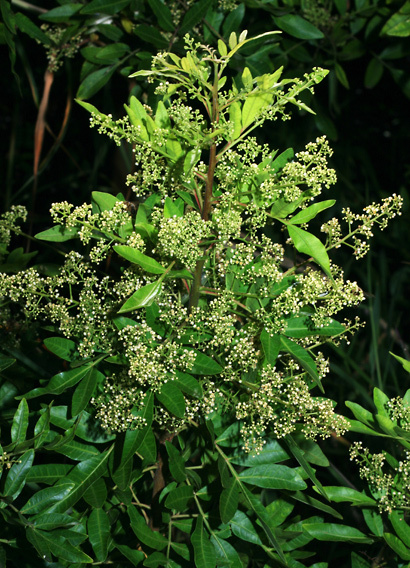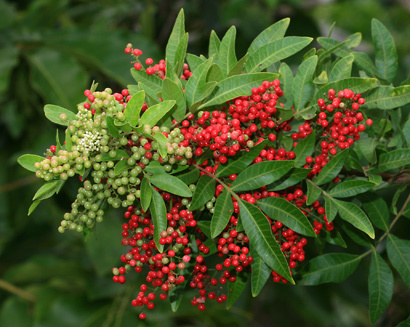Malia asks: We have lots of Christmas berry trees (Schinus terebinthifolia) on our land and want to remove some of them. We were thinking of chipping them to use for mulch in our garden. We are not sure this would be a good idea. Please advise.
Malia asks: We have lots of Christmas berry trees (Schinus terebinthifolia) on our land and want to remove some of them. We were thinking of chipping them to use for mulch in our garden. We are not sure this would be a good idea. Please advise.
Tropical Gardener answer: The wood and leaves of some plants when chipped are allelopathic. That means that they contain phytochemicals that inhibit the growth of neighboring plants. As far as I know, no actual studies have been done exploring the effect of Christmas berry chips (including some leaves) on neighboring plants. Christmas berry trees (Schinus terebinthifolia) are in the Anacardiaceae (cashew) family, which includes poison ivy, poison oak and poison sumac plants, as well as cashew trees. All of these produce oils or saps that can be irritating dermatologically to sensitive people. Given this, the resinous Christmas berry sap in the chips may be irritating to plants as well, especially tender young ones.
One thing we do know is that the tree’s pretty red berries that appear in winter contain seeds. Birds love to eat these berries and spread the seeds, which is one reason the tree has become so widespread and invasive of many native forests. Chipping and spreading berries along with the wood, would likely result in planting lots of Christmas berry weeds.
Test results of allelopathic plants abound on the internet, though none were available for Christmas berry. Among local trees with available test results, neem chips were found to be moderately growth inhibiting.
Running your own test is probably the best way to discover the allelopathic strength of Christmas berry chips, though sometimes simple observation can provide clues. You may have noticed that nothing grows under ironwood trees. The fallen needles are allelopathic. Fallen bamboo leaves also seem to inhibit growth. Several chips from cedar species are sold for use in pathways and likely have some growth inhibiting properties. The strong scent of Christmas berry chips, especially when the leaves are included, suggests allelopathic potential, though weeds do seem to grow under the trees.
Maybe it’s time for you to become a scientist and run a test. Testing for allelopathy is not difficult and your results could be shared here if you like. Take some seeds that you have that germinate quickly. Beans or greens would work. Plant them in two separate pots; one for the test and another as a control. Take the Christmas berry chips and soak them in water. Water the seeds in the test pot with the water with chips in it and water the control pot with water without chips. Within a week or two seedlings should emerge in both pots. Once the true leaves start to appear, you should see a difference, especially if the Christmas berry water is growth inhibiting. If the plants appear to be the same that means Christmas berry chips can be used throughout your garden without ill effect.
You can, of course, run the same test on any chips you are thinking of using for mulch. Mulching is an excellent plan and using chips from trees from your property is a good sustainable practice. Use allelopathic chips for walkways and at a distance from desired plants to prevent weed growth. When mulching, only use chips that break down quickly and won’t inhibit growth in your garden.
While you are running your tests, you can pile up your chips and they will start to break down into compost. Happy testing.
E-mail plant questions to konamg@ctahr.hawaii.edu for answers by Certified Master Gardeners.
Some questions will be chosen for inclusion in this column.
Diana Duff is a plant adviser, educator and consultant living on an organic farm in Captain Cook.
Gardening Events
Friday: “Coffee Berry Borer (CBB) Control” from 10 a.m. to noon at the UH Extension Center in Kainaliu (up the drive across from the Aloha Theater), Latest information on integrated pest management (IPM) against this pest. Free but registration is required. Contact Gina to register at least 2 days prior at 808-322-4892 or go online for more information and to register at https://hawaiicoffee.weebly.com/2017-cbb-workshops.html.
Saturday: “Coffee Pruning Workshop” from 8:30 to 11:30 a.m.at Lehu’ula Farms 79-7350 Mamalahoa Highway in Kealakekua. Covering pruning techniques as well as practices for CBB reduction. Free to KCFA members, $10 to nonmembers (which can be applied to the $25 dues).
“Work Day at Amy Greenwell Garden” from 9 a.m. to 12:30 p.m. Meet at the Visitor Center across from the Manago Hotel in Captain Cook. Volunteers will be able to help with garden maintenance and should bring a brown bag lunch. Water and snacks provided. For more infomration, call Peter at 323-3318.
Farmer Direct Markets
Wednesday: “Sunset Farmers Market,” 2 p.m. to sunset at the north makai corner of the Kmart parking lot.
Wednesday and Friday: “Ho’oulu Farmers Market,” 9 a.m. to 2 p.m. at Sheraton Kona Resort and Spa at Keauhou Bay
Friday: “Pure Kona Market,” 9 a.m. to 5 p.m. at Amy Greenwell Garden in Captain Cook
Saturday: “Keauhou Farmers Market,” 8 a.m. to noon at Keauhou Shopping Center
“Kamuela Farmer’s Market,” 7 a.m. to noon at Pukalani Stables
Sunday: “Pure Kona Green Market,” 9 a.m. to 2 p.m. at Amy Greenwell Garden in Captain Cook
Tuesday through Saturday: “U-Pick greens and produce,” 10 a.m. to 4 p.m. at Tropical Edibles Nursery in Captain Cook.
Plant Advice Lines
Anytime: konamg@ctahr.hawaii.edu
Tuesdays and Thursdays: 9 a.m. to noon at UH-CES in Kainaliu, 322-4892
Mondays, Tuesdays and Fridays: 9 a.m. to noon at UH-CES at Komohana in Hilo, 981-5199 or himga@hawaii.edu


